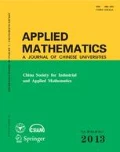Abstract
Bipolar single-valued neutrosophic models are the generalization of bipolar fuzzy models. We first introduce the concept of bipolar single-valued neutrosophic competition graphs. We then, discuss some important propositions related to bipolar single-valued neutrosophic competition graphs. We define bipolar single-valued neutrosophic economic competition graphs and m-step bipolar single-valued neutrosophic economic competition graphs. Further, we describe applications of bipolar single-valued neutrosophic competition graphs in organizational designations and brands competition. Finally, we present our improved methods by algorithms.
Similar content being viewed by others
References
M Akram. Bipolar fuzzy graphs, Information Sciences, 2011, 181(24): 5548–5564.
M Akram. Bipolar fuzzy graphs with applications, Knowledge-Based Systems, 2013, 39: 1–8.
M Akram. Single-valued neutrosophic planar graphs, International Journal of Algebra and Statistics, 2016, 5(2): 157–167.
M Akram, M Sarwar. Novel multiple criteria decision making methods based on bipolar neutrosophic sets and bipolar neutrosophic graphs, Italian journal of pure and applied mathematics, 38(2017), 368–389.
M Akram, S Shahzadi. Neutrosophic soft graphs with application, Journal of Intelligent & Fuzzy Systems, 2017, 32(1): 841–858.
M Akram, M Nasir. Interval-valued neutrosophic competition graphs, Annals of Fuzzy Mathe-matics and Informatics, 2017, 14(1): 99–120.
M Akram, K P Shum. Bipolar single-valued neutrosophic planar graphs, Journal of Mathematical Research with Applications, 36(6) 2017, 631–648.
N O Al-Shehrie, M Akram. Bipolar fuzzy competition graphs, Ars Combinatoria, 2015, 121: 385–402.
K T Atanassov. Intuitionistic fuzzy sets, VII ITKR’s Session, Deposited in Central for Sciences Technical Library of Bulgarian Academy of Science, 1697/84, Sofia, Bulgaria, 1983.
P Bhattacharya. Some remark on fuzzy graphs, Pattern Recognition Letters, 1987, 6: 297–302.
J E Cohen. Interval graphs and food webs: a finding and a problems, Document 17696-PR, RAND Corporation, Santa Monica, CA, 1968.
I Deli, M Ali, F Smarandache. Bipolar neutrosophic sets and their application based on multicriteria decision making problems, In Advanced Mechatronic Systems (ICAMechS), International Conference IEEE, 2015, 249–254.
A Kauffman. Introduction a la theorie des sousemsembles flous, Masson et cie Paris, 1973.
M Nasir, S Siddique, M Akram. Novel properties of intuitionistic fuzzy competition graphs, Journal of Uncertain Systems, 2017, 2(1): 49–67.
S Sahoo, M Pal. Intuitionistic fuzzy competition graphs, Journal of Applied Mathematics and Computer Science, 2015, DOI 10.1007/s12190-015-0928-0.
S Samanta, M Pal. Fuzzy k-competition graphs and p-competition fuzzy graphs, Fuzzy Inf Eng., 2013, 5: 191–204.
S Samanta, M Akram, M Pal. m-Step fuzzy competition graphs, Journal of Applied Mathematics and Computing, 2015, 47: 461–472.
M Sarwar, M Akram. Novel concepts of bipolar fuzzy competition graphs, Journal of Applied Mathematics and Computing, 2016, DOI 10.1007/s12190-016-1021-z.
F Smarandache. Neutrosophic set-a generalization of the intuitionistic fuzzy set, Granular Computing, 2006, IEEE International Conference 38–42 DOI:10.1109/GRC 1635754.
F Smarandache. Neutrosophy, Neutrosophic probability, set and logic, American Res Press, 1998: 7–8.
F Smarandache. A geometric interpretation of the neutrosophic set-A generalization of the intuitionistic fuzzy set, Granular Computing, (GrC), 2011 IEEE International Conference, 2011, 602–606 DOI:10.1109/GRC.2011.6122665.
F Smarandache. Types of neutrosophic graphs and neutrosophic algebraic structures together with their applications in technology, Seminar, Universitatea Transilvania din Brasov, Facultatea de Design de Produs si Mediu, Brasov, Romania, 06 June 2015.
F Smarandache. A unifying field in logics: neutrosophic logic. neutrosophy, meutrosophic set, neutrosphic probability: neutrosophic logic. neutrosophy, neutrosophic set, neutrosophic prbability, Inifinite Study, 2005.
H Wang, F Smarandache, Y Zhang, R Sunderraman. Single valued neutrosophic sets, Multisapace and Multistructure, 2010, 4: 410–413.
S Y Wu. The compositions of fuzzy digraphs, Journal of Research in Education Science, 1986, 31: 603–628.
J Ye, Single-valued neutrosophic minimum spanning tree and its clustering method, Journal of Intelligent Systems, 2014, 23(3): 311–324.
J Ye. Improved correlation coefficients of single-valued neutrosophic sets and interval neutrosophic sets for multiple attribute decision making, Journal of Intelligent & Fuzzy Systems, 2014, 27(5): 2453–2462.
J Ye. A multicriteria decision-making method using aggregation operators for simplified neutrosophic sets, Journal of Intelligent & Fuzzy Systems, 2014, 26(5): 2459–2466.
J Ye. Vector similarity measures of simplified neutrosophic sets and their application in multicriteria decision making, International Journal of Fuzzy Systems, 2014, 16(2).
J Ye. Improved cosine similarity measures of simplified neutrosophic sets for medical diagnoses, Artificial intelligence in medicine, 2015, 63(3): 171–179.
J Ye. Single valued neutrosophic cross-entropy for multicriteria decision making problems, Ap-plied Mathematical Modeling, 2014, 38(3): 1170–1175.
J Ye. Clustering methods using distance-based similarity measures of single-valued neutrosophic sets, Journal of Intelligent Systems, 2014, 23(4): 379–389.
L A Zadeh. Fuzzy sets, Information and Control, 1965, 08: 338–353.
L A Zadeh. Similarity relations and fuzzy orderings, Information Science, 1971, 3(2), (1971): 177–200.
W-R Zhang. Bipolar fuzzy sets and relations: a computational framework for cognitive modeling and multiagent decision analysis, In: Proceedings of IEEE Conference Fuzzy Information Processing Society Biannual Conference, 1994: 305–309.
Author information
Authors and Affiliations
Corresponding author
Rights and permissions
About this article
Cite this article
Akram, M., Nasir, M. & Shum, K.P. Novel applications of bipolar single-valued neutrosophic competition graphs. Appl. Math. J. Chin. Univ. 33, 436–467 (2018). https://doi.org/10.1007/s11766-018-3541-9
Received:
Revised:
Published:
Issue Date:
DOI: https://doi.org/10.1007/s11766-018-3541-9
Keywords
- bipolar single-valued neutrosophic digraphs
- m-step bipolar single-valued neutrosophic economic competition graphs
- algorithm




